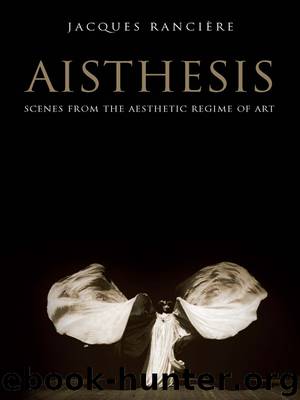Aisthesis by Jacques Ranciere

Author:Jacques Ranciere
Language: eng
Format: epub
Publisher: Verso Books
Published: 2013-05-03T04:00:00+00:00
* * *
1 Maurice Maeterlinck, ‘À propos de Solness le constructeur’, Le Figaro, 2 April 1894. This article was included in the collection edited by S. Gross, Introduction à la psychologie des songes et autres écrits, 1886–1996 (Brussels: Editions Labor, 1985), p. 96–102. Maeterlinck republished a slightly modified version with the title ‘Le tragique quotidien’ in his 1896 collection Le Trésor des Humbles (Brussels: Editions Labor, 1986), pp. 101–10; ‘The Tragical in Daily Life’, in The Treasure of the Humble, transl. A. Sutro (New York: Dodd, Mead & Co., 1913), pp. 95–120. An anonymous English translation of the column also appeared as ‘Maeterlinck on the Drama with Ibsen’s Master Builder as his Text’, New York Times, 13 May 1894.
2 Maeterlinck, ‘À propos de Solness le constructeur’.
3 See the preface by Count Prozor to the translation, Solness le constructeur (Paris: A. Savine, 1893).
4 Stéphane Mallarmé, ‘Hamlet’, Divagations in Oeuvres complètes, vol. II, p. 166. Mallarmé’s text was published in 1886 in the Revue indépendante; ‘Hamlet’, in Divagations, transl. Johnson, p. 124.
5 Andrei Bely, ‘Theatre and Modern Drama’, transl. Laurence Senelik, in Russian Dramatic Theory from Pushkin to the Soviets: An Anthology (Austin: University of Texas Press, 1981), pp. 158–60.
6 Arthur Pougin, Dictionnaire historique et pittoresque du théâtre (Paris: Firmin-Didot, 1885), p. 522.
7 ‘Disguise Melpomene as the muse of scenery / For you tragedy is mise en scène … / Of the Théâtre Français, make an optics no more / Theatre is a temple not a store.’ Léon Halévy, Le Théâtre-Français, épître-satire à M. le baron Taylor (Paris, 1828), p. 18; quoted in Marie-Antoinette Allevy, La Mise en scène en France dans la première moitié du XIXe siècle (Geneva: Slatkine Reprints, 1976), p. 87.
8 Richard Wagner, Opera and Drama, transl. W. Ashton Ellis (Lincoln, NE, and London: University of Nebraska Press, 1995), p. 224.
9 Richard Wagner, The Artwork of the Future and Other Works, transl. W. Ashton Ellis (Lincoln, NE, and London: University of Nebraska Press, 1993), p. 152.
10 Ibid., p. 181. Appia comments on the formula in ‘Musique et mise en scène’, in Œuvres complètes, vol. II (Lausanne: L’ge d’homme, 1986), p. 118; B. Hewitt, ed., Music and the Art of Theatre, transl. R. W. Corrigan and M. D. Dirks (Florida: University of Miami Press), p. 111.
11 Wagner, Opera and Drama, p. 314.
12 Appia, ‘Musique et mise en scène’, p. 82; Hewitt, Music and the Art of Theatre, p. 52.
13 Appia, ‘Musique et mise en scène’, p. 53; Hewitt, Music and the Art of Theatre, p. 17.
14 Adolphe Appia, La Mise en scène du drame wagnérien, in Œuvres complètes, vol. I (Lausanne: L’ge d’homme, 1983), p. 272; Staging Wagnerian Drama, transl. with an Introduction by P. Loeffler (Basel: Birkhäuser Verlag, 1982), p. 59.
15 Staging Wagnerian Drama, p. 59.
16 Stéphane Mallarmé, ‘Solennité’, in Divagations, in Oeuvres complètes, vol. II, p. 200; ‘Solemnity’, in Divagations, transl. Johnson, p. 166.
17 Friedrich von Schiller, On the Aesthetic Education of Man, transl. R. Snell (Mineola, NY: Dover Books, 2004), p. 80.
Download
This site does not store any files on its server. We only index and link to content provided by other sites. Please contact the content providers to delete copyright contents if any and email us, we'll remove relevant links or contents immediately.
The Secret History by Donna Tartt(18213)
Red Sparrow by Jason Matthews(5203)
Harry Potter 02 & The Chamber Of Secrets (Illustrated) by J.K. Rowling(3559)
In a Sunburned Country by Bill Bryson(3376)
Drawing Cutting Edge Anatomy by Christopher Hart(3298)
Figure Drawing for Artists by Steve Huston(3276)
Harry Potter and the Prisoner of Azkaban (Book 3) by J. K. Rowling(3119)
The Daily Stoic by Holiday Ryan & Hanselman Stephen(3113)
Japanese Design by Patricia J. Graham(3005)
The Roots of Romanticism (Second Edition) by Berlin Isaiah Hardy Henry Gray John(2823)
Make Comics Like the Pros by Greg Pak(2763)
Stacked Decks by The Rotenberg Collection(2696)
Harry Potter and the Deathly Hallows (7) by J.K. Rowling(2554)
Draw-A-Saurus by James Silvani(2513)
Tattoo Art by Doralba Picerno(2497)
On Photography by Susan Sontag(2493)
Foreign Devils on the Silk Road: The Search for the Lost Treasures of Central Asia by Peter Hopkirk(2389)
Churchill by Paul Johnson(2374)
The Daily Stoic by Ryan Holiday & Stephen Hanselman(2351)
